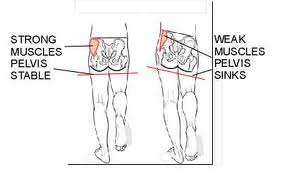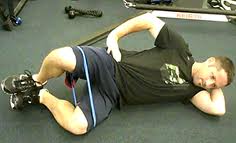Consider some of the locomotion and movement patterns we use most often:
- Ahem, sitting
- Rising from a chair (half squat)
- Walking
- Running straight ahead
Then think about some of the common knee issues people face:
- IT Band Syndrome
- Patellofemoral syndrome
- (Exercise-induced knee pain in general)
The link between the patterns we use most and the problems mentioned above is the lack of movement variety and therefore lack of strength and coordination in the lateral and posterior hip and core muscles. Specifically, we get used to only moving in one direction. We get good at moving forward and neglect our ability to move laterally (and backwards!).
Big mistake.
See, if you want to be strong and stable through the hips (and you do, trust me) as you run forward, then you need strength and coordination in the lateral hip muscles. They play a large role in controlling the amount of lateral pelvic tilt (we want very little) seen in the stride during weight bearing.
When I help someone regain this control, the first thing I do is increase awareness of those muscles. Teaching them the clamshell exercise is one 'entry level' choice. You don't even need to use resistance. Mike Robertson does a nice job of explaining the clamshell here. Some points or cues to consider are:
- Try and really isolate the glutes. You should ONLY rotate from your hips, not from your lower back.
- Turn your torso down towards the ground slightly.
- Place your hand on the back of the hip to facilitate gluteal function.
- Get your neck in neutral! A foam roller or Airex pad under the head will work well here.
A classic lateral stabilization exercise is the side plank ...and I see it performed incorrectly every day. The problem is that everyone is so hip flexor dominant that they inadvertently stick their butt out. It usually doesn't feel that way to them, but with a little tweak you can gain a whole lot more benefit from this exercise!
Alignment is key. Here's how to do it right:
- Lie down next to a wall so that both shoulder blades, glutes, and heels are touching the wall.
- Rise up into the plank and make sure your weight bearing elbow is directly beneath your shoulder.
Another common mistake is downward rotation of your head and upper body.
- Keep your chest proud, shoulders packed down away from your ears, and glutes squeezed. You should be looking straight ahead, not at the floor.
- Your unweighted arm is extended above you and glued to the wall, palm out.
- One way to tell if you're doing this right is to observe your feet. Your weight should be evenly distributed along the edge of the rear half of your foot.
My advice is to start with your legs together and simply hold this position for up to 45 seconds. For the next level in the progression, check out this video. If I catch you trying the advanced version and I see your hips sagging towards the floor, I'm gonna call you out. Own the 45 second version before advancing.
What if you can do 3 sets of 10 reps of the advanced version? If you're that studly, then your lateral glutes are firing loud and clear and your original problem of muscle weakness is gone!
Finally, get in the habit of moving laterally. I start and end each run with side skips (keep toes pointed straight ahead rather than turned out) and “carioca” - about 50 yards each direction. Really simple, but effective.



